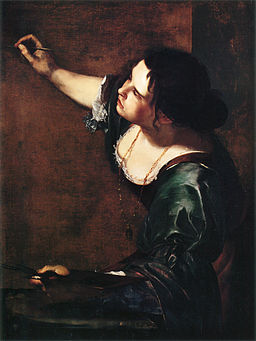Artemisia Gentileschi

Early Life
Artemisia learned painting in her father’s workshop, where she showed greater talent than her brothers. She learned to mix colour, how to draw and how to paint. Her father’s style took inspiration from Caravaggio and this style was also followed by Artemisia. She approached subjects boldly and her works are very naturalistic. While her father encouraged and supported her during an age when women were considered lacking intelligence, he was also jealous of her talent.

One advantage Artemisia had over male painters was that she was able to paint women using nude models. This practice was not allowed at the Accademia so her paintings of the nude Cleopatra and Susanna were rare; her heroic female models Lucretia and Judith expressed strong feminist views which decried the images of women as meek creatures. The strength of these images also questioned the necessity as was common at the time of suicide after suffering humiliation or rape. Her talent was such that she could adapt her style to suit changing tastes and regional requirements.
Traumatic Life

After the trial she was forced into marriage with another painter Pietro Stiattesi and moved to Naples where she struggled to come to terms with marriage, motherhood and the rape trial. Her lifetime seemed to be spent fighting for respect as a woman. Her own emotions seem to come alive in the depiction of historic events and one of her famous works portrays Judith beheading Holofernes. Judith is depicted as a powerful adversary using her strength and emotion to behead her victim. No doubt Artemisia’s life experience surged through the brushes as the biblical heroine powerfully used her sword. By contrast Caravaggio’s depiction of Judith shows a less aggressive more passive Judith.
Charles I

Artemisia knew Galileo and they were both connected to the Grand Ducal Court in Florence, and members of the Accademia del Disegno. Artemisia used Galileo’s discovery of the parabolic path of projectiles to depict such authentic spray from blood in the painting of Judith. “Judith Slaying Holofernes“, painted around 1620, was likely commissioned for Cosimo II de Medici, who actually hid the painting as he believed it was too horrific to gaze upon.
Artemisia Gentileschi did not have an exhibition of her own until 1991 in Florence. Undiscovered until the latter part of the 20th century, Artemisia’s work was often attributed to her father or ignored by art historians and critics.

Dear Su at Deepspace.
Interesting artist featured here. fascinating woman fascinating work. I have a book about her life.
Thank you, Deepspace.
Thank you Jennie. Yes Artemesia is still inspirational today through what we know of her inner strength as well as her powerful imagery. Would love to see that book. Su